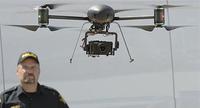-
Beijing to track individual movement through cell phones

Beijing could soon track the daily movements of seventeen million residents by tapping into their cell phones; authorities have proposed a program designed to help ease traffic congestion by providing up to the minute data on an individual’s movements; critics say that this is an attempt by authorities to prevent large crowds from forming; the proposed plan comes as Chinese officials have grown increasingly worried about domestic unrest in light of the mass protests sweeping across the Middle East; Chinese police forces turned out in full force after anonymous calls for mass protests were posted online; the government has also placed more than eighty activists under house arrest while others have gone missing
-
-
Video Surveillance Clock keeps watch
If you want to keep an eye on the goings-on in your home or office while you are away, you may want to consider the Video Surveillance Clock; the small (2 3/4″ Diam. x 3/4″ D ) analog clock has a built-in, motion-activated video surveillance camera that records both audio and video and takes photographs too
-
-
Officials say unified government-wide databases with shared access is the future
Federal agencies are looking to reduce the “stove piping” of information by using a “person-centric view” to open proprietary databases that store information within a particular agencies to allow state, local, and federal agencies to access it and share information; these databases depend on developing common identification and access systems where employees would use a single credential to access information; the Department of Justice and the FBI have rolled out programs that embrace this philosophy; N-DEx is a database that collects criminal case files, past histories, and other pertinent information and makes it available to investigators at all levels
-
-
Using location-based services to protect infrastructure
Location-based services (LBS) have enabled marketing firms to alert mobile phone users of nearest coffee shops and eateries as well as help phone owners find their geographical location on hand-held mapping devices; now, location based service enabled phones can help protect critical infrastructure facilities by alerting authorities about threats and giving them time to apprehend intruders
-
-
FBI retreats from push to expand surveillance capabilities on Web
The FBI recently retreated from calling for a push to introduce legislation that would require all Web-based email services and social networking sites to build backdoor access for law enforcement officials; when granted permission to conduct wiretaps by the courts, the FBI and other investigative agencies are unable to successfully monitor communications on encrypted channels like social networking sites and Web-based email servers; at a House hearing the FBI distanced itself from reports that suggested it was seeking legislation to demand backdoors on encrypted networks; the FBI believes that it can obtain the information using other means; the agency was not clear on how it plans to move forward
-
-
Police uneasy about cheap smart-phone scanner app
Just a few years ago, someone wanting to listen to the dispatches of their local police department had to purchase and program special equipment; now, modern technology has made it possible to transform popular smart phones into personal police scanners; police say that criminals could use the increased accessibility provided by the new technologies as a tool for committing crimes
-
-
Are your phones really secure?
Breakthroughs in technology have enabled malicious actors to listen in on any conversation using your phone even when not in use; eavesdroppers have circumvented encrypted audio channels by relying on a relatively simple principle in physics — resonance; by tapping into an object’s natural resonance, spies have turned phones and phone cables into listening devices even when they are not in use; researchers at Teo, a manufacturer of secure telecommunications equipment, were able to capture human voices using standard phones, unplugged Ethernet cables, or even a rock; to address this security gap, Teo has designed its IP TSG-6 phones with special vibration dampening circuitry and materials that render them impervious to these types of listening devices
-
-
Android apps send private data in the clear

Cell phones running the Android operating system fail to encrypt data sent to and from Facebook and Google Calendar, shortcomings that could jeopardize hundreds of millions of users’ privacy; Facebook’s recently unveiled always-on SSL encryption setting to prevent snooping over insecure networks — but the encryption is no good, meaning that all private messages, photo uploads, and other transactions are visible to eavesdroppers
-
-
U.S. appealing warrantless wiretapping court defeat
In the first and likely only lawsuit resulting in a ruling against the secret National Security Agency warrantless surveillance program adopted in the wake of the 9/11 terror attacks, a San Francisco federal judge in December awarded $20,400 each to two American lawyers illegally wiretapped by the George W. Bush administration, and granted their counsel $2.5 million for the costs litigating the case for more than four years; the Obama administration is appealing the judge’s ruling
-
-
Hummingbird-sized UAV developed

A bird-sized unmanned aerial vehicle that flaps wings for propulsion and hovering has been developed by the U.S. company AeroVironment; The aircraft has a wingspan of 6.5 inches and has a total flying weight of two-thirds of an ounce, which is less than the weight of a common AA battery
-
-
Do security cameras deter crime?
As federal agencies, cities, and local police departments spend more money on vast networks of closed circuit surveillance cameras, some critics are wondering whether these systems are an effective way to stop crime and a good use of resources; various studies on the efficacy of security cameras have been inconclusive; some studies have shown that cameras in Chicago and Baltimore have helped deter crime, while others have shown that cameras in Los Angeles and Britain have had no impact on crime; one critic points out that studies that show cameras are effective do not weigh benefits against spending more money on beat cops, probation programs, and other law enforcement options
-
-
Canadian police push limits of civilian UAVs laws

A local police department in Ontario, Canada is exploring the use of small unmanned aerial vehicles (UAVs) and pioneering civil aviation laws for future use of these aerial drones; in 2007 the Kenora Police Department set a new precedence when photographs of a homicide scene, taken from a UAV, were admitted as evidence in a trial for the first time; unlike the large drones used in Afghanistan these smaller UAVs are not practical for surveillance and are primarily used to record photos for trials and provide aerial reconnaissance in hostage situations or bomb threats; the small UAVs are equipped with several cameras including digital still, video, and Forward Looking Infrared (FLIR) camera; the Canadian government is working on developing regulations for the use of these UAVs in civilian airspace
-
-
U.S. communities support surveillance systems
Despite calls by the ACLU to halt the expansion of the use of CCTVs in public places, towns across the United States are eager to get their hands on the extra sets of eyes; midsized communities across the United States are installing more surveillance video cameras in an effort to cut down on crime, without having to spend more money on additional law enforcement officials
-
-
SkyWatch: surveillance as effective deterrence
ICx’s SkyWatch mobile surveillance tower help police and businesses keep an eye on crowded areas and public events, helping in deterring car theft and burglary, assault, disturbances, and robbery; ICx points out that the SkyWatch tower is designed with darkened windows so those below cannot tell if an officer is present — so whether or not the police have the ability to man it, the deterrence still works
-
-
Lack of oversight doomed SBInet, could hamper replacement
The poor oversight and contractor management that hampered the recently cancelled SBInet could plague its replacement; numerous GAO reports blasted DHS for failing to properly communicate and supervise its primary contractor Boeing; the program suffered major cost overruns and failed to deliver on project goals due to limited input from end users, shifting priorities, and poor communication; in response to criticism, DHS has hired more contracting officers and is reviewing acquisition procedures; critics are skeptical of DHS’ ability to deliver SBInet’s replacement which incorporates much of the same technology
-
- All
- Regional
- Water
- Biometrics
- Borders/Immig
- Business
- Cybersecurity
- Detection
- Disasters
- Government
- Infrastructure
- International
- Public health
- Public Safety
- Communication interoperabillity
- Emergency services
- Emergency medical services
- Fire
- First response
- IEDs
- Law Enforcement
- Law Enforcement Technology
- Military technology
- Nonlethal weapons
- Nuclear weapons
- Personal protection equipment
- Police
- Notification /alert systems
- Situational awareness
- Weapons systems
- Sci-Tech
- Sector Reports
- Surveillance
- Transportation
Advertising & Marketing: advertise@newswirepubs.com
Editorial: editor@newswirepubs.com
General: info@newswirepubs.com
2010-2011 © News Wire Publications, LLC News Wire Publications, LLC
220 Old Country Road | Suite 200 | Mineola | New York | 11501
Permissions and Policies
Editorial: editor@newswirepubs.com
General: info@newswirepubs.com
2010-2011 © News Wire Publications, LLC News Wire Publications, LLC
220 Old Country Road | Suite 200 | Mineola | New York | 11501
Permissions and Policies
